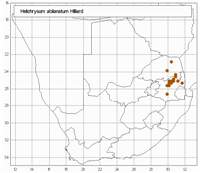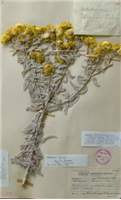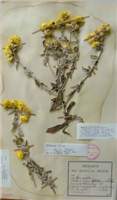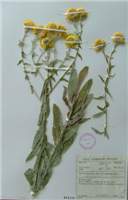Origin of name:
albus = dull white
lanatus = woolly
Diagnostic characters:
Bright yellow bracts
Large solitary heads
Description:
Subshrub up to 1 m tall, stock with vegetative buds, stems many from the base forming rounded clumps, woody, brittle, virgate, forking above into the compound inflorescence, thinly silvery-grey appressed woolly, long red patent glandular hairs as well, closely leafy. Leaves mostly 35�60 x 11�20 mm, 20�40 x 6�15 mm on the inflorescence branches, smaller near the heads, lanceolate, acute to shortly acuminate, base more or less cordate-clasping, lower surface thickly silvery-grey appressed woolly, long red patent glandular hairs as well, upper surface generally appressed woolly, but wool sometimes wanting and then surface merely glandular-setose. Heads heterogamous, (10�) 12�13 mm long, (20�) 25�28 mm across the radiating bracts, depressed-globose, several in a very open terminal leafy corymbose panicle, or subsolitary on side branches. Involucral bracts in c. 9 series, graded, imbricate, inner much exceeding the flowers, glossy, bright yellow, sometimes overlaid pale brown outside. Receptacle shortly honeycombed. Flowers c. 750�950, 90�125 female, 640�850 homogamous. Achenes 1 mm long, glabrous. Pappus bristles many, equaling the corolla, tips subplumose, shaft scabrid, bases cohering by patent cilia.
Flowering between January and June.
Distribution:
In rocky montane grassland and marginal to forest patches. Recorded only from the highlands of Mpumalanga, from about Mariepskop in the north to Belfast district in the south. In shallow stony soil in high-lying areas.
Savanna and Grassland Biomes.
Notes:
H. albilanatum is frequently confused with H. decorum but is easily distinguished by its differently shaped and more silvery leaves, and its smaller heads. Furthermore, H. decorum is confined to the coastal areas of the Eastern Cape, KwaZulu-Natal and Mozambique.
H. albilanatum can be confused with grey-leaved plants of H. mutabile, but that species has oblong rather than lanceolate leaves, mostly 4�13 mm broad, not 11�20 mm.
Hilliard & Burtt 14370 (E; NU; PRE) from Long Tom Pass, Mount Anderson, appears to be a hybrid between H. albilanatum and H. molestum, while Hilliard & Burtt 14371 (E; K; NU; PRE) appears to be a hybrid between H. albilanatum and H. aureolum; all the putative parents were growing in close proximity. Hilliard & Burtt 14396 (E; K; NU; PRE) and Hilliard & Burtt 14204 (E; NU) represent a number of plants that are probably H. albilanatum x H. difficile; they grew on the grass slope between a dolerite outcrop (H. albilanatum) and a marsh (H. difficile). All these supposed hybrids were intermediate in character between the probable parents.
Taxonomy:
Literature:
Helichrysum albilanatum Hilliard in Notes R. bot. Gdn Edinb. 40: 249 (1982).
Type:
Mpumalanga, 2530 BA, 8 km from Lydenburg on Sabie road, rocky grassland, 5 iii 1981, Hilliard & Burtt 14193 (NU, holo.; E; K; M; PRE; S, iso.).
Synonym(s):
Vouchers:
Hilliard & Burtt 14202 (E; K; NU; PRE); Hutchinson 2745 (BOL; K; PRE); Smuts 19 (K; PRE); Wilms 712 (BM; E; G); Burgoyne 148 (PRE).



